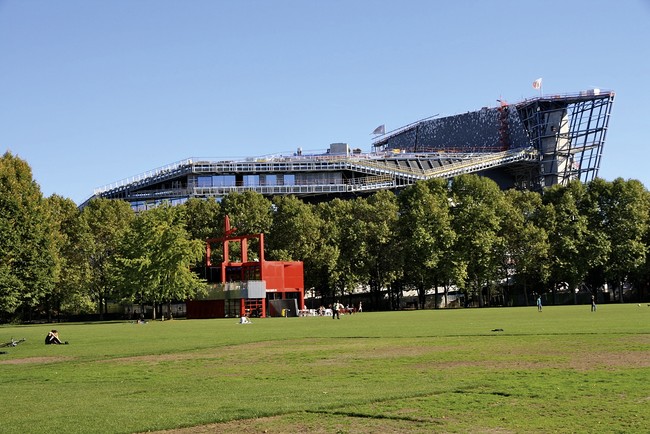
The day of the gala opening of his design for the Philharmonie de Paris, January 14, Jean Nouvel announced he would not attend. The building is not ready for orchestras, he said in a statement released by his office. “There were no acoustic tests in the concert hall. The schedule did not allow the architectural and technical requirements to be respected.” The 2,400-seat concert hall rises like a shiny iceberg of mottled metal and rippling polished stainless steel in the Parc de la Villette at the northeast corner of the city. But much of the exterior paneling had yet to be installed, and scaffolding was everywhere, including in the auditorium, as recently as yesterday.
 |
| Photo © James S. Russell Looking toward the public entrance of the Philharmonie de Paris, next to Christian de Portzamparc's Cité de la Musique, October 2014.
|
It had seemed inconceivable that the promised January opening date would be achieved. The joint project of the French state and the city of Paris stuck to its schedule, however, and the Orchestre de Paris and other resident companies are presenting three days of gala concerts, even though the rushed opening flirts with disaster. (The project missed its original, unrealistic completion date of 2012, and should not be publicly inaugurated “peacefully and with dignity,” until fall, said Nouvel's statement.)
Poor early reviews could damage the hall’s reputation for a long time. It’s happened before, at Philadelphia’s Kimmel Center, designed by Rafael Viñoly. That hall opened in 2001, before its adjustable acoustical elements were fully working, to reviews that ranged from mixed to blistering. On the basis of that experience the Los Angeles Philharmonic rehearsed in Frank Gehry’s Walt Disney Concert hall for six months before it opened—work that paid off in a warm reception and a consensus that the acoustics are excellent.
There’s also considerable criticism of the location, in the park designed by Bernard Tschumi, for being too far from western Paris neighborhoods where much of the concert-going audience resides and where concerts have been played at the acoustically troubled Salle Pleyel. The new hall also has drawn catcalls for its cost: €380 million ($450 million), far more than the original budget of €200 million. Press reports that the costs are the fault of Ateliers Jean Nouvel are “unfounded,” the statement continued, citing a 2012 government report on the project’s ballooning costs and delays. “I will not tolerate that untruthful, defamatory and disparaging writings or comments are made about me,” the statement said.
The competition-winning design introduces a unique, hybrid acoustical conception devised by acousticians Harold Marshall, of New Zealand-based Marshall Day, and Yasuhisa Toyota, of Tokyo’s Nagata Acoustics (Disney’s acoustician). (Take a virtual tour here.) It marries the long, narrow, time-honored “shoebox” to the “vineyard” style championed by Toyota, where seating tiers wrap the orchestra. The acoustical advantages of the shoebox are combined with the intimacy and audience-involving experience of the vineyard. The balconies, which swirl around the room in sensuous curves, rise freestanding within the ovoid auditorium envelope on pylons. Marshall uses the air volume behind the seats as a means to produce an audience-enveloping sound. An adjustable sound-diffusing “cloud,” suspended above the stage, can alter the sound to suit the size of ensemble and type of music played. Seats behind the orchestra retract to create additional flat-floor seating and reconfigure the stage for a wide variety of non-Classical performance.
This complexity suits the aspirations of the hall to spur performance innovation and draw new audiences (especially from the culturally neglected suburbs). Opening the building now has become a political necessity, since the project has come to be seen as a too-prominent boondoggle in recession-strangled France. The opening could still become a celebration of art and a means to transcend cultural differences after the terrorist attacks of recent days.
The hall’s vaunting aspiration to energize its environs and redefine the concert-going experience could be for naught if the shortcuts and loss of time to fine tune prove crucial. On the other hand, if the sound and the experience wow early audiences, all of the struggle will quickly be forgotten.


Post a comment to this article
Report Abusive Comment